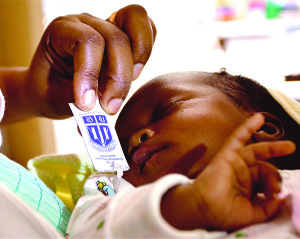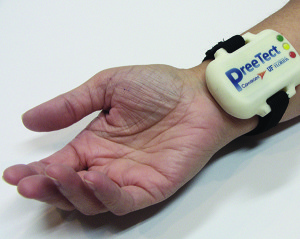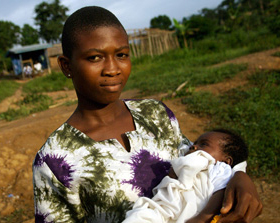
Launched in 2011, this partnership between USAID, the Bill & Melinda Gates Foundation, and the Governments of Canada, Norway, and the UK, is a global competition to identify and support groundbreaking solutions to infant and maternal mortality in some of the world’s poorest and hardest to reach places.
The 59 previous finalists – who were selected from thousands of applicants – were provided with seed-like grant funding to test, prove, and scale up new approaches and cutting-edge technologies that have the potential to save more women and children than ever before.
 The Pratt Pouch: Today around 1,000 babies worldwide will contract HIV, 90 percent of whom will receive the virus from their mothers. The Pratt Pouch, which looks like a ketchup packet, is a “squeezable” oral antiretroviral medication that is revolutionizing the treatment of HIV-positive newborns. Saving Lives at Birth selected the Pratt Pouch in 2011 to give Duke University Professor Dr. Robert Malkin and his students the chance to really test the Pratt Pouch – and it worked.
The Pratt Pouch: Today around 1,000 babies worldwide will contract HIV, 90 percent of whom will receive the virus from their mothers. The Pratt Pouch, which looks like a ketchup packet, is a “squeezable” oral antiretroviral medication that is revolutionizing the treatment of HIV-positive newborns. Saving Lives at Birth selected the Pratt Pouch in 2011 to give Duke University Professor Dr. Robert Malkin and his students the chance to really test the Pratt Pouch – and it worked.
Winning the grand challenge for development in years passed – 2014 included – has helped turn their innovative idea into a global solution that is reaching mothers and treating infants in multiple countries, with plans this year to “transition the Pratt Pouch to scale in Zambia.”
 PreeTect: In sub-Saharan Africa, around 15 percent of pregnant women develop preeclampsia. These women are also far more likely to die from the high blood pressure disorder, but if caught early, the mortality rate is low. This is why Saving Lives at Birth selected a highly portable space-age wristband designed by experts from the University of Florida and Convergent Engineering to detect preeclampsia 10-12 weeks before the onset of symptoms.
PreeTect: In sub-Saharan Africa, around 15 percent of pregnant women develop preeclampsia. These women are also far more likely to die from the high blood pressure disorder, but if caught early, the mortality rate is low. This is why Saving Lives at Birth selected a highly portable space-age wristband designed by experts from the University of Florida and Convergent Engineering to detect preeclampsia 10-12 weeks before the onset of symptoms.
Early trials in Africa show the “PreeTect” device, which measures and transmits data about a patient’s vitals to local health workers’ mobile phones, is already predicting with 85 percent accuracy who was going to get Preeclampsia.
 Saving Lives at Birth: Saving Live at Birth is part of a global effort to reduce maternal mortality, which has dropped by 45 percent from 1990 to 2013. And while much remains to be done to achieve the Millennium Development Goal of reducing maternal mortality by 75 percent by 2015, partnering public and private resources with new technologies provides an awesome opportunity to leapfrog conventional approaches and reach more mothers-to-be and their babies all over the world.
Saving Lives at Birth: Saving Live at Birth is part of a global effort to reduce maternal mortality, which has dropped by 45 percent from 1990 to 2013. And while much remains to be done to achieve the Millennium Development Goal of reducing maternal mortality by 75 percent by 2015, partnering public and private resources with new technologies provides an awesome opportunity to leapfrog conventional approaches and reach more mothers-to-be and their babies all over the world.
** USGLC is proud to feature the Pratt Pouch and the PreeTect as Innovations in Smart Power– sponsored by The Coca-Cola Company, Carlson Companies, Land O’Lakes, and PYXERA Global – which highlights how America’s most forward-thinking businesses, NGOs, and universities are working with one another and with the federal government in new and exciting ways to tackle some of the toughest global problems**
This week previous Saving Lives at Birth winners and a new group of finalists are showcasing their transformational ideas at the DevelopmentXChange Marketplace, held in the Ronald Reagan Building in downtown Washington, D.C. on Friday, August 1, 2014.